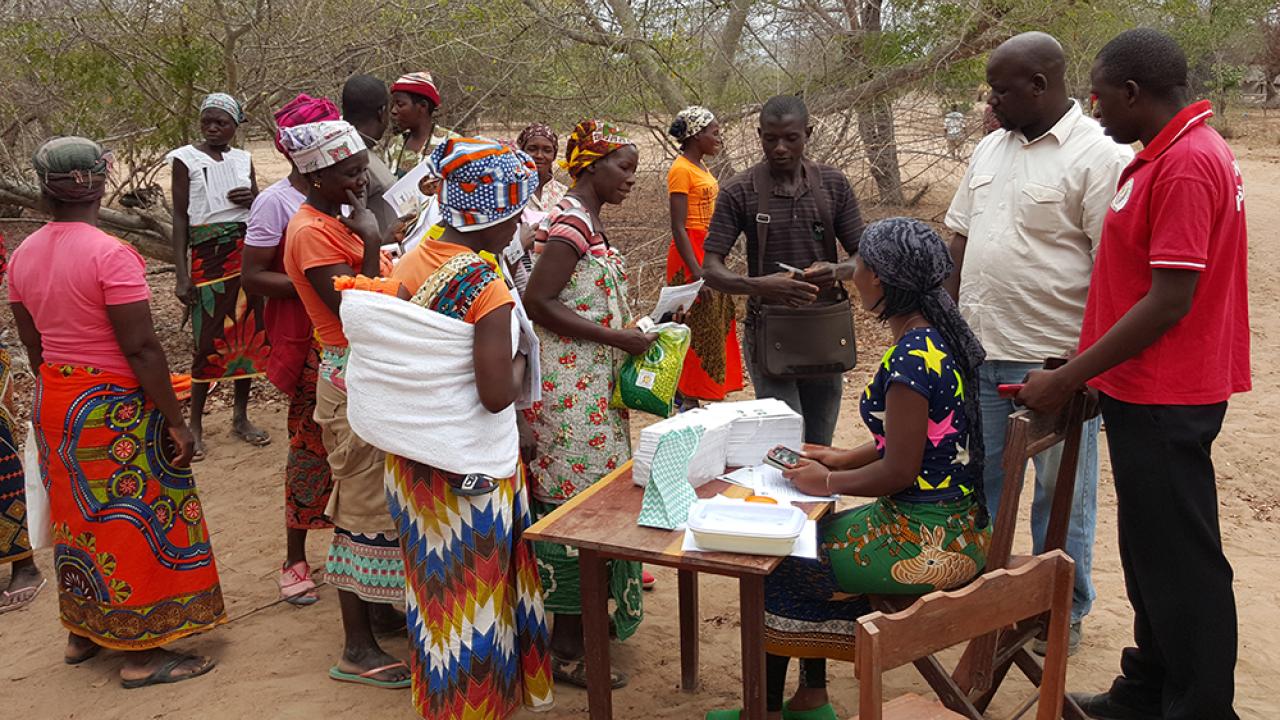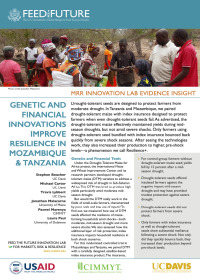
Drought-tolerant seeds are designed to protect farmers from moderate drought. In Tanzania and Mozambique, we paired drought-tolerant maize with index insurance designed to protect farmers when even drought-tolerant seeds fail. As advertised, the drought-tolerant maize effectively maintained yields during mid-season droughts, but not amid severe shocks. Only farmers using drought-tolerant seed bundled with index insurance bounced back quickly from severe shock seasons. After seeing the technologies work, they also increased their production to higher, pre-shock levels—a phenomenon we call Resilience+.
Genetic and Financial Tools
Key Points
- For control-group farmers without drought-tolerant maize seed, yields fell by 15 percent after a mid-season drought.
- Drought-tolerant seeds offered insulated farmers against the negative impact mid-season drought and may have provided modest protection against severe drought.
- Drought-tolerant seeds did not protect farmers from severe shock.
- Only farmers with index insurance as well as drought-tolerant seeds show substantial resilience following a severe shock. Not only did they quickly bounce back, they increased their production beyond pre-shock levels.
Under the Drought-Tolerant Maize for Africa project, the International Maize and Wheat Improvement Center and its research partners developed drought-tolerant maize (DTM) varieties to address a widespread risk of drought in Sub-Saharan Africa. This DTM was bred to produce high yields particularly amid moderate mid-season drought.
But would the DTM really work in the fields of small-scale farmers, characterized by poor soils and low use of inputs? To find out, we measured how use of DTM seeds affected the resilience of maize-farming households amid shocks—both moderate, mid-season drought and more severe shocks. We also assessed how the additional layer of risk protection, index insurance impacts household resilience in both shock scenarios.
For this randomized controlled trial in Mozambique and Tanzania, we paired DTM with a carefully designed, satellite-based index insurance product. The insurance, which added 20 percent to the seed cost, replaced seeds in the season following severe shocks if yield losses reached 35 percent. Among our sample of maize farming households, some were offered only DTM seeds, some were offered DTM seeds bundled with insurance, and a control group was offered neither.
Farmers in our sample managed small, rain-fed maize plots. We collected yearly data after maize harvests from 2016-18. Seed and insurance marketing took place in partnership with five local seed companies and two local insurance companies prior to planting for the 2016-17 and 2017-18 seasons. Over the course of the study period, some farmers encountered mid-season drought and/or severe shock.
Varied Shock Experience
Control-group farmers, who were not offered DTM seeds, experienced low levels of productivity that were very sensitive to drought. In seasons with normal rainfall, control-group farmers averaged about 960 kg/ha in maize yields. With moderate mid-season droughts, yields fell by nearly 15 percent, and by nearly 30 percent amid severe shock. The control-group farmers generally showed resilience to moderate drought—the drought did not have any lingering effects. In contrast, they exhibited low resilience to severe shocks, with very low maize production the following year despite normal rainfall.

Treatment group farmers, who planted DTM, may have slightly higher (not statistically significant) yields in normal rainfall years. During seasons with moderate mid-season drought, the DTM variety almost completely offset losses. However, DTM offered little benefit amid severe shocks; during these times, DTM yields also dropped significantly.
The value of index insurance becomes apparent amid severe shocks. Insured farmers received replacement seed for planting, which helped them quickly recover from the shock. Their yields were much higher than those of other farmers in the following season.
Changing Investment Levels
Yields in normal rainfall years following a shock were largely determined by farmers’ investment, specifically two mechanisms: (i) area and (ii) intensity of maize cultivation.
Farmers who faced a severe shock and did not have index insurance reduced their cultivation of maize from an average of 2.0 hectares to 1.4 hectares, a 30 percent reduction. They also dramatically reduced their input expenditures per hectare by a factor of three or more. Thus, it appears that these shocks decapitalized the farming operation and may have dampened farmers’ desire to invest in an activity recently shown to be highly vulnerable. As a result of reduced investment, non-insured farmers’ production the following season was below pre-shock levels, despite normal rainfall, reflecting low resilience.
Meanwhile, farmers who had index insurance and realized its protective benefits following severe shock increased their investment levels. First, the insurance seed payout gave these households a leg up. Then, seeing that their investments in maize fields would be recovered amid bad times—through DTM seed amid moderate drought and through index insurance amid severe shock—insured farmers invested more. They doubled their expenditures per hectare and expanded their maize cultivation area by approximately 50 percent. Overall production increased by 67 percent. We call this phenomenon, whereby coverage with risk management tools induces people to increase their productive investments, Resilience+.
Shock-exposed insured farmers continued using insurance managing their risk. However, farmers who were insured but did not experience a shock during the study period missed experiencing the risk management benefits and backed away from using insurance. This result reflects the challenge of building sustained uptake of technologies that only infrequently reveal their benefits.
This brief summarizes the paper:
Boucher, S.R., Carter, M.R., Flatnes, J.E., Lybbert, T.J., Malacarne, J.G., Mareyna, P.P., Paul,L.A. 2024. “Bundling Genetic and Financial Technologies for More Resilient and Productive Small-Scale Farmers in Africa.” The Economic Journal.
For discussion of measuring resilience with this data, see MRR’s “Measuring Economic Resilience with the Cumulative Avoided Losses Metric.”
This report is made possible by the generous support of the American people through the United States Agency for International Development (USAID) cooperative agreement 7200AA19LE00004. The contents are the responsibility of the Feed the Future Innovation Lab for Markets, Risk and Resilience and do not necessarily reflect the views of USAID or the United States Government.
